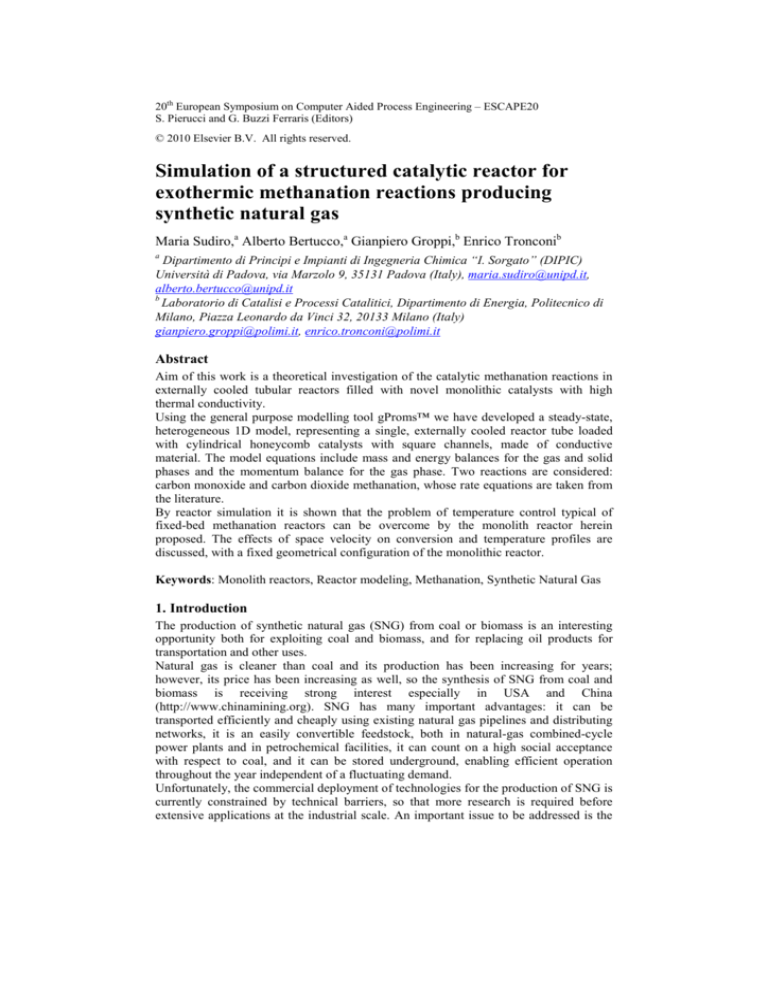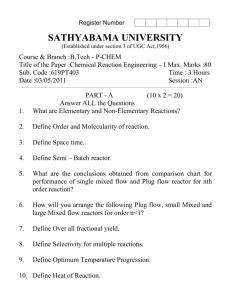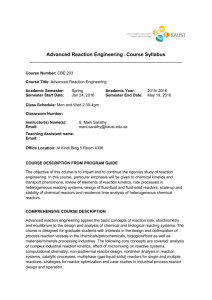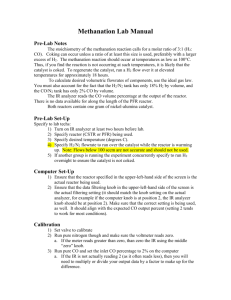
20th European Symposium on Computer Aided Process Engineering – ESCAPE20
S. Pierucci and G. Buzzi Ferraris (Editors)
© 2010 Elsevier B.V. All rights reserved.
Simulation of a structured catalytic reactor for
exothermic methanation reactions producing
synthetic natural gas
Maria Sudiro,a Alberto Bertucco,a Gianpiero Groppi,b Enrico Tronconib
a
Dipartimento di Principi e Impianti di Ingegneria Chimica “I. Sorgato” (DIPIC)
Università di Padova, via Marzolo 9, 35131 Padova (Italy), maria.sudiro@unipd.it,
alberto.bertucco@unipd.it
b
Laboratorio di Catalisi e Processi Catalitici, Dipartimento di Energia, Politecnico di
Milano, Piazza Leonardo da Vinci 32, 20133 Milano (Italy)
gianpiero.groppi@polimi.it, enrico.tronconi@polimi.it
Abstract
Aim of this work is a theoretical investigation of the catalytic methanation reactions in
externally cooled tubular reactors filled with novel monolithic catalysts with high
thermal conductivity.
Using the general purpose modelling tool gProms™ we have developed a steady-state,
heterogeneous 1D model, representing a single, externally cooled reactor tube loaded
with cylindrical honeycomb catalysts with square channels, made of conductive
material. The model equations include mass and energy balances for the gas and solid
phases and the momentum balance for the gas phase. Two reactions are considered:
carbon monoxide and carbon dioxide methanation, whose rate equations are taken from
the literature.
By reactor simulation it is shown that the problem of temperature control typical of
fixed-bed methanation reactors can be overcome by the monolith reactor herein
proposed. The effects of space velocity on conversion and temperature profiles are
discussed, with a fixed geometrical configuration of the monolithic reactor.
Keywords: Monolith reactors, Reactor modeling, Methanation, Synthetic Natural Gas
1. Introduction
The production of synthetic natural gas (SNG) from coal or biomass is an interesting
opportunity both for exploiting coal and biomass, and for replacing oil products for
transportation and other uses.
Natural gas is cleaner than coal and its production has been increasing for years;
however, its price has been increasing as well, so the synthesis of SNG from coal and
biomass is receiving strong interest especially in USA and China
(http://www.chinamining.org). SNG has many important advantages: it can be
transported efficiently and cheaply using existing natural gas pipelines and distributing
networks, it is an easily convertible feedstock, both in natural-gas combined-cycle
power plants and in petrochemical facilities, it can count on a high social acceptance
with respect to coal, and it can be stored underground, enabling efficient operation
throughout the year independent of a fluctuating demand.
Unfortunately, the commercial deployment of technologies for the production of SNG is
currently constrained by technical barriers, so that more research is required before
extensive applications at the industrial scale. An important issue to be addressed is the
M. Sudiro et al.
strong exothermicity of the reactions, so that conventional fixed-bed catalytic reactors
cannot be safely used (Sudiro et al., 2009a).
The use of monolith catalyst supports offers at least two advantages with respect to
conventional packed-bed reactors: pressure drops are greatly reduced (to less than 1%)
and the radial heat transport can be more favorable, especially when metallic support are
used. Such monoliths have in fact the advantage of favorable global heat-transfer
properties resulting from heat conduction in the connected structure of their solid
matrix; this problem has been extensively investigated theoretically (Groppi and
Tronconi, 1996; Groppi and Tronconi, 2000). Application of monolith catalysts has
already been shown as technically feasible, both by simulation in the case of the
oxidation of methanol to formaldehyde and epoxidation of ethylene (Groppi and
Tronconi, 2001) and experimentally at the pilot-reactor scale (Groppi et al., 2008;
Groppi et al., 2000; Tronconi and Groppi, 2000) in the case of strongly exothermic
gas/solid reactions, such as catalytic o-xylene selective oxidation and CO oxidation.
In this way significantly more heat can be removed and structured catalyst are eligible
to be used for strongly exothermic gas/solid reactions. Favourable heat transfer
properties permit reducing risk of thermal runway and catalyst deactivation. To this end,
our aim is to verify the possibility of overcoming the problem of temperature control,
typical of fixed-bed, for methanation reactions, if they are carried out in monolith
reactors.
2. Reactor modeling
It is assumed that catalytic methanation reactions occur in an externally cooled tubular
reactors filled with novel monolithic catalysts with high thermal conductivity.
2.1. Model equations
The behavior of the methanation reactor is modelled by a dynamic 1D, heterogeneous,
single-tube model of an externally cooled multi-tubular fixed-bed reactor, which is
loaded with honeycomb catalysts.
The model includes the specie mass balances and the energy balances for the gas and
solid phases, and the momentum balance for the gas phase.
Mass balances for the gas phase are expressed by:
ε
∂wi , g
∂t
=−
Wt ∂wi , g K m,i a
⋅
−
⋅ wi , g − wi , s
ρ g ∂z
ρg
(
)
(1)
whereas those for the solid phase are:
tanh ϑ j
NR
0=
∑υ
i, j
j =1
ϑj
(
R j PM iξ + K m,i a wi , g − wi , s
)
(2)
Energy balance for the gas phase is written as:
ερc p
∂Tg
∂t
= −Wtc p
∂Tg
∂z
(
− ha Tg − Ts
whereas that for the solid phase is:
)
(3)
Simulation of a structured catalytic reactor for exothermic methanation reactions
producing synthetic natural gas
ρ s c p ,s (1 − ε )
ϑj
4
) ∑ − ∆H R, j tanh
R j ξ − hwall (Ts − Twall )
ϑj
d
(
∂Ts
∂ 2T
ha
= k s ,ax (1 − ε ) 2s +
Tg − Ts +
1− ε
∂t
∂z
j =1
NR
(4)
The momentum balance is according to the following equation:
1
Wt ∂P Wt 2 ∂Tg 1 Wt 2
−
+ 2
−
=
af
ρ g ρ g P ∂z ρ g2T ∂z
2 ρ g2
(5)
Boundary conditions at reactor inlet and outlet are reported in Table 1.
Table 1. Boundary conditions
Reactor inlet (z=0)
wi , g
z =0
− k s , ax
= wi , feed ; Tg
∂Ts
∂z
z =0
z =0
Reactor outlet (z=L)
= T feed ; P z = 0 = Pfeed
= σ ⋅ ε s ⋅ Tg4 − Ts4
− k s , ax
z =0
∂Ts
∂z
z=L
= σ ⋅ ε s ⋅ Tg4 − Ts4
z=L
Initial conditions are: wi , g ( z , t = 0) = wi , feed , Tg ( z , t = 0) = Tcoolant , Ts ( z , t = 0) = Tcoolant .
The following gas-solid heat and mass transfer correlations for honeycomb monoliths
have been adopted to calculate Nusselt and Sherwood numbers in the square celled
monoliths:
(
)
e
(
)
e
Nu = 3 + 6.874 ⋅ 1000 ⋅ z *Nu
*
Sh = 3 + 6.874 ⋅ 1000 ⋅ zSh
−0.488 − 57.2⋅ z *
Nu
−0.488 − 57.2⋅ z *
Sh
, where z *Nu =
z
d eq RePr
(6)
z
d eq Re Sc
*
, where zSh
=
(7)
The following expression for calculation of friction factors in the square monolith
channels was adopted in the model:
(
f Re = 14.227 + 17.76323 ⋅ 1000 ⋅ z *f
)
−0.4715 −59.57 ⋅ z *f
e
, where z *f =
z
d eq Re
(8)
Dimensionless numbers are defined in Table 2:
Table 2. Dimensionless numbers
Pr =
µ g c p, g
kg
; Re =
d eqWt
εµ g
; Nu =
d eq h
kg
; Sc i =
µg
ρ g Di , g
Sh i =
K m,i d eq
ρ g Di, g
Thermal properties, such as specific heat and heat of reaction, were estimated according
to the CHEMKIN correlations (Smith et al., 2009), and gas properties, such as
conductivity, viscosity and diffusivity, were calculated according to the correlations
reported by Sudiro et al., (2009b). The system of equations was solved by using the
general purpose tool gProms™, adopting 200 grid points along the axial direction.
The reactor has a length of 1 m with an inner diameter of 0.254 m. The monolith pitch
is set to 2 mm, values of the catalytic washcoat (ξ) and of fraction of metallic support
(λ), are 0.2 and 0.25, respectively.
M. Sudiro et al.
The wall heat transfer coefficient was set to 500 W/m2 K, according to the results of
Groppi and Tronconi, (2005) for a monolith in tight contact with the reaction tube,
whereas the thermal conductivity of the monolith support was set to 200 W/m K (Al).
2.2. Kinetic scheme
The following two reactions (CO and CO2 methanation) have been considered:
CO + 3H 2 → CH 4 + H 2 O
(9)
CO + 4H 2 → CH 4 + 2H 2O
(10)
The CO methanation kinetic was derived from Sughrue, 1982, the one of CO2
methanation from Weatherbee, 1982. Rate expression for CO methanation on Ni
catalyst is:
0.2 ⋅ k1k 2 p H 2
mol
=
⋅ ρ catalyst
rCO
3
2
m s k 1 + K 0.5 p 0.5 + K p + k 1 + K p 2
1
2
CO CO
CO CO
H2 H2
(11)
where k1, k2, kH2, kCO depend on the temperature according to an Arrhenius/power law
expression. The rate expression for CO2 methanation on Ni catalyst is:
mol
=
rCO 2
3
m s
pCO
2
1 + B
pH 2
0.5
0.2 ⋅ A ⋅ pCO
p 0.5
2 H2
0.5
p
+ C pCO 2 p H 2 0.5 + CO
D
(
)
2
⋅ ρ catalyst
(12)
Constant A, B, C and D are tabulated as a function of temperature. In order to explore
intensified process conditions, rCO and rCO2 were incremented by 40% in all the
simulations.
3. Results and discussion
Figure 1 shows the calculated axial profiles of gas temperature (1a) and conversion of
H2, CO and CO2 along the reactor (1b). Coolant temperature was set to 573K, as
reactions start at T>>240°C (Odermatt, 2008). A feed (60% mol H2, 20% mol CO and
20% mol CO2) with a H2/CO molar ratio of 3 was assumed, and the GHSV was set to
15000 h-1, as reported by Rostrup-Nielsen, 2007, which is a typical value for pilot
plants. The inlet pressure was set to 6.9 bar.
800
Tgas
Tmonolith
Conversion %
Temperaure (K)
750
700
650
600
550
0
0.1
0.2
0.3
0.4
0.5
0.6
0.7
0.8
0.9
1
100
90
80
70
60
50
40
30
20
10
0
0
0.1
0.2
0.3
H2 conversion
(1a)
0.4
0.5
0.6
0.7
0.8
0.9
1
Reactor Length (m)
Reactor Length (m)
CO conversion
CO2 conversion
(1b)
Figure 1. Axial profiles of temperatures and conversions
It is interesting to show that with only one monolithic reactor a high conversion of
hydrogen and carbon monoxide can be obtained (98 and 83%, respectively), with a
Simulation of a structured catalytic reactor for exothermic methanation reactions
producing synthetic natural gas
moderate and acceptable increase of temperature along the reactor, avoiding catalyst
deactivation with respect to existing methanation processes. Here at least three reactors
and a recycle of a part of the products are required (Sudiro et al., 2009a, Topsøe, 2009):
recycle is needed for controlling the temperature using products as inert and three
reactors are required to achieve high conversion.
For comparison, if the same gas flow rate were sent to an equilibrium adiabatic reactor
the output temperature would be higher (about 1000K), with a CO conversion of 81%,
similar to that obtained with the monolith reactor, but with the consequence of a total
deactivation of the catalyst.
3.1. Sensitivity analysis
The effect of a progressive increase of the flow rate value was investigated in order to
improve the productivity (see Figure 2). A higher gas flow rate, and correspondingly a
greater value of GHSV, results in the shift of the hot-spot towards the bed exit (in this
conditions the reactions tend to the extinction). In fact, the increase of gas flow rate
results in an enhanced convective heat removal, so that the temperature increment
generated by the reaction heat is lower, which in turn slows down the reaction rate.
As a result, at increasing space velocity a decrease of CO conversion can be observed.
750
CO conversion %
Gas Temperaure (K)
800
700
650
GHSV
600
550
0
0.1
0.2
0.3
0.4
0.5
0.6
0.7
0.8
0.9
1
100
90
80
70
60
50
40
30
20
10
0
GHSV
0
0.1
Reactor Length (m)
GHSV=15000
GHSV=18000
GHSV=20000
(2a)
0.2
0.3
0.4
0.5
0.6
0.7
0.8
0.9
1
Reactor Length (m)
GHSV=25000
GHSV=15000
GHSV=18000
GHSV=20000
GHSV=25000
(2b)
Figure 2. Gas temperature (a) and CO conversion (b) axial profiles at four different GHSV
4. Final remarks
In this work the possibility of using monolithic reactors carrying out exothermic
methanation reactions from syngas was investigated by process simulation. A model of
a dynamic 1D, heterogeneous, single-channel model of an externally cooled fixed-bed
reactor, loaded with honeycomb catalysts, was developed and solved, using gProms™
as process simulator.
It was shown that synthetic natural gas can be produced in a single pass monolithic
catalyst reactor, with acceptable conversion values and temperature hot spots
compatible with the catalyst stability. This system improves the presently adopted
process configurations, as it overcomes the problem of temperature control typical of
fixed-bed methanation reactors.
The use of monolith reactors is also useful in view of process intensification: we have
verified that the GHSV can be increased up to 20000 h-1, with minimal pressure drops,
increasing the cooling temperature correspondingly, without the risk of reactor runway.
Further improvements might be obtained by adopting more active catalyst formulations.
Nomenclature
a = specific area (1/m), a = 4ε / d eq
cp = mass specific heat (J/kg K),
kW = active washcoat conductivity (1.2 W/m K)
L = reactor length (m)
m = monolith pitch (m) (2 mm)
M. Sudiro et al.
(cp,s=865 kJ/kg)
D = diffusivity (m2/s)
d = monolith (or reactor) diameter (m)
deq = hydraulic diameter of the monolith
channel (m), d eq = m ε
f = friction factor
h = gas-solid heat transfer coefficient in the
monolith channel (W/m2 K)
hwall = wall heat transfer coefficient
kg = gas mixture conductivity (W/m K)
Km,i = gas-solid mass transfer coefficient in
the monolith channel (kg/m2 s)
ks,ax = effective axial conductivity (W/mK),
k
k s , ax = k s λ + ξ W
ks
ks = support conductivity (Al=200 W/m K)
Greek Letters
δw = thickness washcoat (m),
δw = ε + ξ − ε
ε = bed void fraction (0.7)
εs = emissivity of solid phase (0.7 for Al)
λ = volume fraction of inert support (0.25)
Subscripts and Superscripts
ax = axial
g = gas phase
s = solid phase
Nu = Nusselt number
P = pressure (Pa); p = partial pressure
PMi = molecular weight of the specie i (kg/kmol)
Pr = Prandtl number
Re = Reynolds number
Rj = j reaction rate (kmol/m3 s)
R = universal gas constant (8314 J/kmol K)
Sci = Schmidt number
Shi = Sherwood number
T = temperature (K)
t = time (s)
v = gas velocity (m/s)
wi = weight fraction of the specie i
Wt = specific mass flow rate (kg/m2 s)
Wtot = mass flow rate (kg/ s)
z*f = axial coordinate for friction factor
z*Nu = axial coordinate for Nusselt number
z*Sh = axial coordinate for Sherwood number
µ = viscosity (kg/m s)
ξ = volume fraction of active phase (0.2)
∆HR,j = heat of reaction (J/kmol)
θ = Thiele modulus
ρ = density (kg/m3), ρs=3800 kg/m3, ρw=900 kg/m3
σ = Stefan-Boltzmann constant (5.67·10-8 W/m2 K4)
υ = stoichiometric coefficient
w = active washcoat or catalytic phase
wall = reactor wall
References
Groppi G. and E. Tronconi, AIChE J., 42 (1996), 2382-2387.
Groppi G. and E. Tronconi, Chem. Eng. Sci., 55 (2000), 2161-2171.
Groppi G., G. Airoldi, C. Cristiani, E. Tronconi, Catal. Today, 60 (2000), 57-62.
Groppi G. and E. Tronconi, Catal. Today, 69 (2001), 63-73.
Groppi G. and E. Tronconi, Catal. Today, 105 (2005), 297-304.
Groppi G., E. Tronconi, F. Cruzzolin, C. Cortelli, R. Leanza, and S. Marsaud, Development and
industrial pilot tests of novel conductive structured catalysts for o-xylene oxidation to phthalic
anhydride. In Book of Abstracts of ISCRE20, The 20th International symposium on Chemical
Reaction Engineering, 7-10 September 2008, Kyoto-Japan, pp. 150-151.
Rostrup-Nielsen J.R., K. Petersen and J. Sehested, Appl. Catal., A, 330 (2007), 134-168.
Smith, G.P., D.M. Golden, M. Frenklach, N.W. Moriarty, B. Eiteneer, M. Goldenberg, C.T.
Bowman, R.K. Hanson, S. Song, W.C. Gardiner, Jr., V.V. Lissianski and Z. Qin
http://www.me.berkeley.edu/gri_mech/
Sudiro M., C. Zanella, L. Bressan, M. Fontana and A. Bertucco. Synthetic natural gas (SNG)
from petcoke: model development and simulation. In Proceedings of ICheaP-9, The ninth
International Conference on Chemical & Process Engineering, 10-13 May 2009a, Rome-Italy,
pp. 1251-1256.
Sudiro M., M. Pellizzaro, F. Bezzo and A. Bertucco, Chem. Eng. Res. Des., (2009b). In Press.
Sughrue, E. L. and C. H. Bartholomew, Appl. Catal., 2 (1982), 239-256.
Topsøe, H. (2009). http://www.topsoe.com
Tronconi E. and G. Groppi, Chem. Eng. Sci., 55 (2000), 6021-6036.
Weatherbee, G. D. and C. H. Bartholomew, J. Catal., 77 (1982), 460-472.
www.chinamining.org









